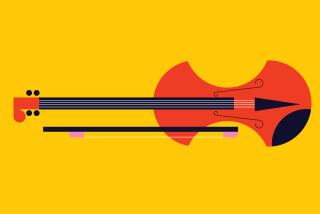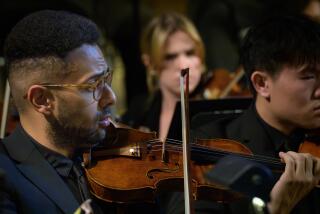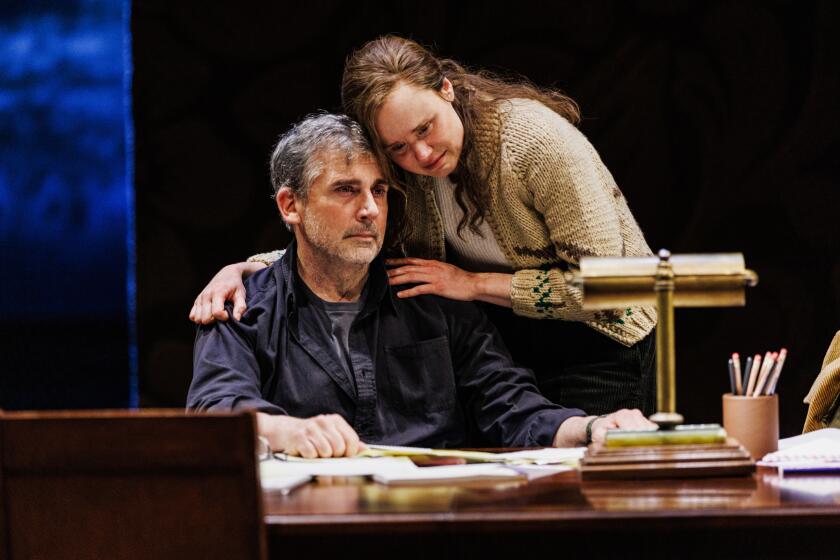Orchestre Revolutionnaire et Romantique brings vintage sound
When is a violin not just a violin? Or a horn not simply a horn? The instruments used in period-music ensembles are museum-quality objects brought to life — a bit of European history invigorated by musicians of today.
Though most period ensembles are small, the Orchestre Révolutionnaire et Romantique is an atypical example of a large-scale group that has embraced the pre-modern aesthetic. The orchestra will perform Beethoven concerts Monday and Tuesday at the Renée and Henry Segerstrom Concert Hall as part of a tour that included a recent stop at Carnegie Hall in New York.
The British orchestra features close to 80 players of 14 nationalities. Led by conductor John Eliot Gardiner, they will replicate the sound of a concert from the late Beethoven era — a period in the early 19th century that followed the Baroque but predated the emergence of the contemporary orchestra as we know it today.
PHOTOS: Arts and culture by The Times
This means different things for different musicians. Principal horn player Anneke Scott said she is playing an original 1820 instrument created by France’s Marcel Auguste Raoux. The instrument, which she owns, costs about 12,000 euros (about $15,000) — nearly twice the amount of a contemporary French horn.
Scott said the period instrument has more in common with a hunting horn than the modern French horn. For one thing, it plays fewer notes, only those of the harmonic series. To create chromatic notes, the musician must physically mold the sound coming from the bell.
“We have to do these strange things with our right hand,” she explained. By placing her hand in the bell of the horn, she can change the sound to create notes that the instrument can’t produce on its own.
Concertmaster Peter Hanson plays a violin dating from 1756 that was created in Milan, Italy, by Giovanni Battista Guadagnini. The instrument, on loan to him, costs as much as a small apartment in London, he said.
To create a period sound, the string section plays on strings made from the intestines of a sheep or a goat. (Though called “catgut” strings, they are not made from dead felines.) Today, most strings are metallic and contain synthetic materials.
Violins will use less vibrato than they do in contemporary performances. “The thickness of the gut strings gives you most of the richness you need,” said Hanson.
The Orchestre Révolutionnaire will perform Beethoven’s “Missa Solemnis” and Symphony No. 9 with the Monteverdi Choir. The concerts are part of the Beethoven series hosted by the Philharmonic Society of Orange County.
The orchestra came to Southern California in 1999 to perform the cycle of Beethoven symphonies. Gardiner, who founded the group in 1989, said that recent years have been difficult for the orchestra.
“The recession has hit us badly. But it’s a delayed effect. It’s really only kicked in now,” Gardiner said. The group doesn’t receive government funding and relies on touring income and private donations, he said.
Musicians with the orchestra are freelancers, though many have played with Gardiner for years. They are responsible for providing their own period instruments and for insuring them during trips.
The delicacy of certain woodwind instruments can pose challenges for musicians. Principal flutist Marten Root said he owns a period instrument worth 60,000 euros, but he chose to bring a contemporary replica of the flute on this tour.
“I don’t want to risk being with the original,” he explained. “The humidity on an airplane is very low on a long flight. It can crack.”
The period flute is conical rather than cylindrical and has a more piercing sound that can be heard through the orchestra. Root said his original instrument is ebony with ivory rings made from the tusks of elephants.
Timpanist Robert Kendell is playing a set of instruments 115 years old. He said he owns other timpani from the Beethoven era, but they are more delicate and difficult to transport.
The three timpani he is bringing on tour are worth about $20,000, he said. Compared to modern timpani, they are smaller and provide a sound that has more effect but doesn’t last as long. “It dies more quickly,” Kendell explained.
To replicate a period sound, he uses wooden sticks instead of modern sticks wrapped with flannel or felt.
The tempo that Gardiner takes with the Beethoven pieces has a more driving and urgent force than contemporary interpretations. “He conducts with passion and precision,” said Esther Brazil, a singer with the Monteverdi Choir. For Beethoven’s Ninth, the “dynamic contrasts are bigger and the tempo is faster.”
Gardiner said his passion for period playing comes from “wanting to get as close as one can to the composer one cherishes.”
He said that players “approach the music with greatest confidence if you establish what sounds the composer intended. When you do that, it gives new life to the music.”
Orchestre Révolutionnaire et Romantique
Where: Renée & Henry Segerstrom Concert Hall, Costa Mesa
When: 8 p.m. Monday for “Missa Solemnis”; 8 p.m. Tuesday for Symphony No. 9
Tickets: $30 to $250
Information: philharmonicsociety.org or (949) 553-2422
MORE
INTERACTIVE: Christopher Hawthorne’s On the Boulevards
TIMELINE: John Cage’s Los Angeles
PHOTOS: Arts and culture in pictures
More to Read
The biggest entertainment stories
Get our big stories about Hollywood, film, television, music, arts, culture and more right in your inbox as soon as they publish.
You may occasionally receive promotional content from the Los Angeles Times.







